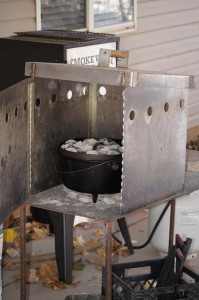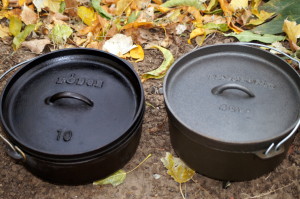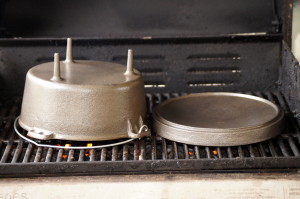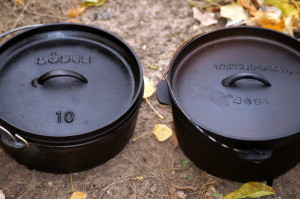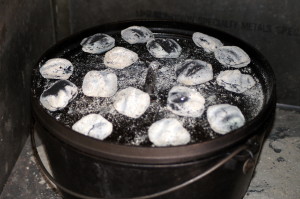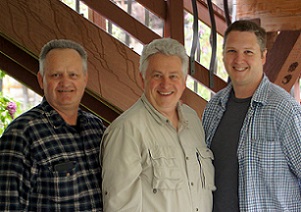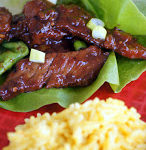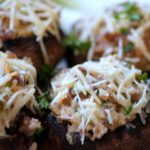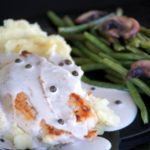Introduction
If I could only have one item to cook in for the rest of my life, I would choose a Dutch Oven. Why? You can cook anything! You can bake, stew, fry and boil. You can bake rolls and breads, dinners and desserts. I don’t know of anything you can’t cook in a Dutch Oven. No wonder there were pioneer women who carried them across the plains, tied to their aprons! Cooking in cast iron is also good nutrition. I recently read an article that stated;
“Your trusty cast-iron skillet doesn’t just deliver mouthwatering caramelized crusts and a perfectly rustic presentation. Turns out, it really can boost the iron content of your food and help you work more of the sometimes hard-to-get mineral into your diet.
But just how much more? Compared to cooking in nonstick pans, you can get as much as 16 percent more iron from cooking in cast iron, according to a study published in the Indian Journal of Pediatrics. However, other research shows that not all foods end up getting the same iron boost. “Acidic foods absorb the most iron, likely because vitamin C enhances iron absorption,” says registered dietitian Jessica Cording.”
So let’s bust out some cast iron dutch ovens and skillets and get to cooking!
Dutch Oven Basics
Originally Dutch ovens had a flat bottom and a dome lid. With time, the use and style has changed. Today the term Dutch oven refers to what we call a camp oven. It has a flat lid with a flange around the edge to hold charcoal and three legs on the bottom to hold it above your source of heat.
Dutch ovens can be made out of cast iron or aluminum. Both have their advantages and disadvantages. Cast iron requires seasoning to prevent the pot from rusting. Cast-iron also distributes heat more evenly and retains it’s heat longer. Aluminum heats up more quickly, but it also cools faster and can have hot-spots. Aluminum is much lighter and easier to carry around. Although cast-iron can be very heavy, most people prefer cast-iron for its cooking qualities and the flavor it brings to food.
Dutch ovens come in all different sizes and are traditionally 4 inches deep. You can find them as small as 5 inches and as large as 16 inches in diameter. The size of Dutch oven you want to use depends on what you’re cooking. Eight and 10 inch ovens are great for side dishes and vegetables. The most commonly used Dutch oven is a 12 inch oven (it has a 6-quart capacity), and is used for main dishes and desserts. 16 inch ovens are wonderful for baking your rolls and pizzas. You can also find “deep” ovens that are 6″ deep.
An 8″ oven will hold 2 quarts.
A 10″ oven is 4 quarts
A 12 ” oven is 6 quarts
A 14″ oven is 8 quarts
A 16″ oven is 12 quarts
Selecting a Dutch Oven
Be careful in selecting your new Dutch oven. Some very good ovens are cast or made in the United States by companies like Lodge or Camp Chef but others are now made in India and China. Make sure the walls of the oven are of a uniform thickness and that the lid sits flat on the oven and does not teeter back and forth, but is snug. Check for pockmarks or imperfections in the casting process.
Seasoning your Dutch Oven
These days a lot of cast iron pans come pre-seasoned and are ready to use. Proper seasoning helps food not to stick; the better the seasoning the better the pot. It also helps your pot not to rust. Seasoning should increase with time and use. If you need to season a new pan, or re-season an old pot that needs help, it is pretty easy to do.
1. Wash the pan and lid inside and out with warm water and a mild soap. Rinse with clean water and dry completely.
2. Coat all surfaces with a thin coating of cooking oil. Wipe off any excess with a paper towel. or a used rag. Make sure that no oil is allowed to pool.
3. Place the pan and lid upside down in an oven or gas grill. I like to use the grill because the smells stay out side. Heat to 325 – 375 degrees and bake for 30 – 45 minutes. Handel your pans with welding gloves or pot holders; they will be very hot.
4. Repeat steps 2 & 3 several times (at lease 3 or 4). After you are finished, turn off the oven and let the pan completely cool.
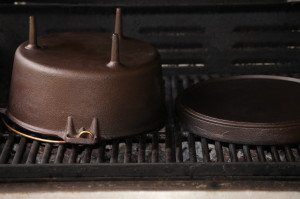
Notice the difference after putting oil on 4-times and cooking for 30 minutes between each application.
When cooking in a newly conditioned pot,cook meals with oils, like hamburger or chicken with the skin on. The oils will help with the seasoning deepen. Initially, avoid tomatoes and other acidic dishes.
If a pot is old, crusty or rusted, scour with some steel wool or an SOS pad until you have gone down to the bare metal. Then start with step 1 and continue through the seasoning process.
Care and maintenance
Dutch Ovens are one of the easiest things to care for, but you do need to take care of them. Cleaning is easy with just some hot water and a nylon scrubbing pad. Loosen and remove all leftover food from the oven and add some warm water. Be careful to NEVER add cold water to a hot oven or hot water to a cold oven. You can crack them! (I have cracked one and I cried for weeks. I still use it for breads and dinners that don’t have a lot of liquid.) Set your oven back on your leftover coals to get everything heated-up. Then scrub away. Dry your oven with paper towels and add a very light coat of oil both inside and out, this will prevent rust. Be careful not to leave oil to pool, because it will become rancid.
I never use soap to clean my ovens because it can remove your seasoning. However – if you cook something with a strong flavor, like cinnamon, it will bake into your pot and can carry over to the next meal. To prevent this, you can (and my wife does) use a drop of soap when you clean your oven, but just a drop!
Store your oven with either the lid cracked (to allow for air ventilation) or with the lid off. This will also avoid the oil from getting a rancid smell.
Heating your Dutch Oven
You can use several materials for heat including wood, natural charcoal and charcoal briquettes. Charcoal briquettes offer a more consistent heat. Cook your recipes at the same temperature in a Dutch oven as you would in your kitchen oven. Two briquettes provide 20 – 25 degrees of heat. To heat your oven to approximately 325 degrees, use twice as many briquettes as the diameter of your oven. A 12″ oven would use 24 briquettes. I use a 2/3 and 1/3 method with 2/3 of the charcoal on top of the lid and 1/3 underneath the bottom. Less bottom heat will help prevent burning your dinner. If you need to raise or lower the temperature just add or subtract a few coals. Charcoal should be spread out in a uniform pattern on top of and beneath the oven.
How long will a bag of charcoal last if you had to plan meals for your family? My friend Richard Smith will tell you. By finding the weight of a charcoal briquette, he estimates that there are around 265 charcoal in a 20 pound bag of Kingsford Charcoal. If a 12 inch oven requires 24 briquettes to cook at 325 degrees, and two more to cook at 350 degrees, then 265 briquettes divided by 26 equals ten meals from a 20 lb. bag. Therefore, a 20 lb. bag of Kingsford should deliver 10 meals with some broken charcoal left over. If you are cooking a main dish and a dessert you would have five meals from one bag.
Dutch Oven accessories
Aside from your oven, you only need a couple of things to get started! You will need a pair of long-handled tongs for moving charcoal and a lid lifter. You can purchase a lid lifter or you can use a claw hammer or a pair of pliers.
That’s it for the basics. There are other accessories you can use that are helpful, but not necessary. A metal cooking table is helpful to get you off the ground, but a piece of aluminum foil on a hard, level surface works fine. A charcoal starter comes in handy and can be lit by placing crumpled newspaper underneath, or you can set it on a gas burner. A lid holder will keep your lid off the ground, and a wind shield can be helpful on a breezy day.
